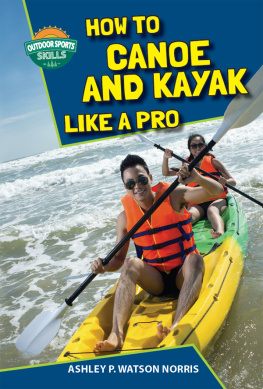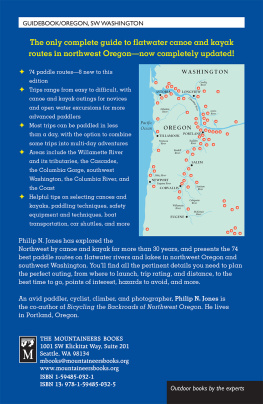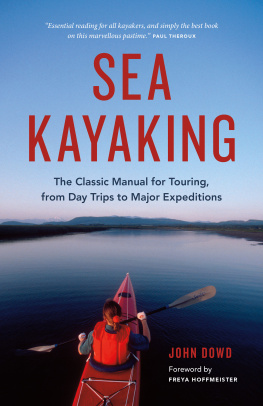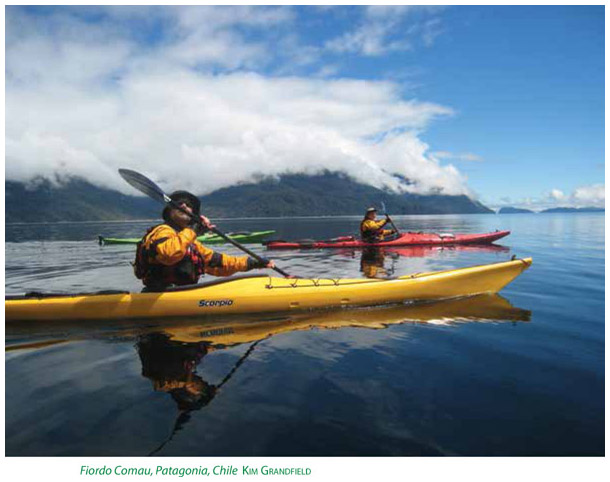
An imprint of Rowman & Littlefield
Falcon and FalconGuides are registered trademarks and Make Adventure Your Story is a trademark of Rowman & Littlefield.
Distributed by NATIONAL BOOK NETWORK
Copyright 2016 by Rowman & Littlefield
All rights reserved. No part of this book may be reproduced in any form or by any electronic or mechanical means, including information storage and retrieval systems, without written permission from the publisher, except by a reviewer who may quote passages in a review.
British Library Cataloguing in Publication Information Available
Library of Congress Cataloging in Publication Data
Names: Schumann, Roger.
Title: Basic illustrated sea kayaking / Roger Schumann.
Description: Revised Edition. | Guilford, Connecticut:FalconGuides, [2016] |Distributed by NATIONAL BOOK NETWORKT.p. verso. | Includes index.
Identifiers: LCCN 2015048554 (print) | LCCN 2015050602 (ebook) | ISBN 9781493016518 (paperback : alk. paper) | ISBN 9781493024582 (e-book)
Subjects: LCSH: Sea kayaking.
Classification: LCC GV788.5.S37 2016 (print) | LCC GV788.5 (ebook) | DDC 797.122/4dc23
LC record available at http://lccn.loc.gov/2015048554
 The paper used in this publication meets the minimum requirements of American National Standard for Information SciencesPermanence of Paper for Printed Library Materials, ANSI/NISO Z39.48-1992.
The paper used in this publication meets the minimum requirements of American National Standard for Information SciencesPermanence of Paper for Printed Library Materials, ANSI/NISO Z39.48-1992.
The author and Rowman & Littlefield assume no liability for accidents happening to, or injuries sustained by, readers who engage in the activities described in this book.
Introduction
Sleek and full of promise, theres something inherently alluring about a sea kayak. Even the shyest of toddlers waddling down the beach will stop and stare before venturing closer, drawn to the cockpit like the needle of a compass to north. Shell look back at her parents, eyes hopeful, wordlessly begging the question: Can I sit in it, pleeease? The parents may translate the question aloud but will be too shy to ask for themselves. But you can often see their own desire in their eyes as well.
Sea kayaks move people, both physically and literally, like some sort of visual pheromone. But it goes beyond the visual. If you listen closely to a sea kayak at rest on the beach, its not hard to imagine the howl of an arctic wolf or the wind.
Or not.
Sea kayaks are also accessible, versatile, accommodatingas adventurous or tame as you care to get. Theyre as well suited for a for a weeks-long expedition down Alaskas Inside Passage or a Patagonian fiord as they are for a trip to the local lake for an early morning of floating and fishing, a lazy summer afternoon at the beach with the kids, or an evening workout to clear your head after a hard days work.
A sea kayak is sleeker and more seaworthy than a canoe, easier to launch than a motorboat, and so user-friendly that most people will need little or no instruction to operate oneat least not until they tip over, which at some point is virtually inevitable, and where having a little knowledge can be convenient at least and could save a life at best.
This book, among other things like gear and paddling skills, will cover safety and introduce trip planning strategies to help you avoid potentially dangerous situations. The Getting Started sections in each chapter focus on the basics. The Getting Serious sections include more advanced skills for those ready to go beyond the basics. Either way, seek competent instruction along your learning journey. No matter how well written, books are supplemental information and not intended to replace on-water training sessions.
The more skills you gain, the farther afield you can explore. Kayaks in skilled hands are amazingly seaworthy and can take you pretty much anywhere you want to go. People in kayaks have crossed the Atlantic, more than once; crossed the Pacific from Monterey Bay, California, to Maui; circumnavigated Australia, twice; and completed a three-year rounding of South America. For most of us, our goals will likely be less ambitious than crossing oceans and circling continentsto simply catch a whiff of salt-sea air on the weekend, catch a fish, or catch a few easy waves after work will be enough to justify the time and effort it takes to build our skills to a comfortable levelbut the potential is there. Waiting. Just beyond the next bend in the shoreline, just over the horizon.
Section I:
Boats and Gear
CHAPTER ONE
Sea Kayaks and Sea Kayakers
A kayak without a kayaker, its been said, is like a body without a soul. It requires a partner to animate it and transform both of you. When slipping into their sealskin kayaks, ancient kayak hunters from maritime cultures considered themselves able to shape-shift into marine mammalson even footing with the ones they set out to catch.
If hunting seals to survive, you needed a long, narrow kayak that was sleek and stealthy, efficient and seaworthy for covering long miles at sea. Inland cultures hunting caribou at river crossings used shorter, wider kayaks that didnt need to be efficient just to paddle a couple hundred meters from shore, just stable and maneuverable enough to dart around a heard of thrashing caribou. As a modern kayaker, youll need to decide what youre huntingbe it a little solitude or a big adventure, a little exercise or a big fishand choose a kayak (or kayaks) thats best suited.
Types of Kayakers: What Level Paddler Do You Want to Be?
Give some thought to the type of kayaker you are now and the one you want to become so that you dont end up trying to hunt seals on the open sea in a boat better suited for caribou. Also consider the necessary skill set implied with where you want to go.
For talking about skill levels or the relative difficulty of sea conditions you feel comfortable paddling in, its helpful to have a scale such as the one snow skiers use, with ratings like black diamonds and blue squares. A bit less colorful, the Level 1 through Level 5 scale on the facing page is based on the one the American Canoe Association uses. One of the largest paddlesports organizations in the world, the ACA provides safety and skills education to recreational paddlers and certification for instructors in canoeing, rafting, stand up paddle boarding (SUP), and kayaking. The scale considers both how rough the water conditions are and distance from shelter. Any terms you dont yet know will be explained in subsequent chapters; for now, knots can be substituted with miles per hour.
As with any system, lines drawn are somewhat arbitrary, and kayakers may not fit neatly into boxes. Nonetheless, its a good starting point for getting a sense of the sorts of challenges presented at each level. Below is some elaboration on the skill levels.










 The paper used in this publication meets the minimum requirements of American National Standard for Information SciencesPermanence of Paper for Printed Library Materials, ANSI/NISO Z39.48-1992.
The paper used in this publication meets the minimum requirements of American National Standard for Information SciencesPermanence of Paper for Printed Library Materials, ANSI/NISO Z39.48-1992.


